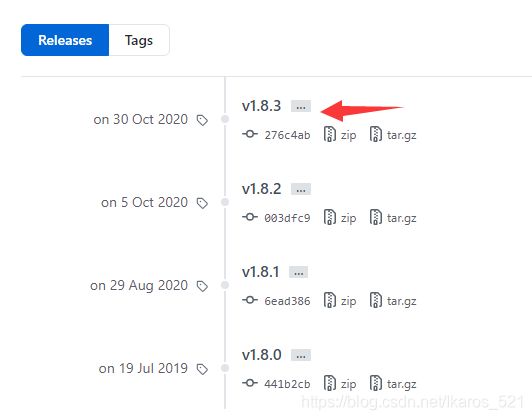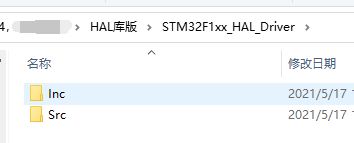Keil5创建HAL库版本的STM32F103ZET6工程,实现简单的LED亮灭demo
前言
本文主要参考文章:新建基于STM32F103ZET6的工程-HAL库版本
因为 Mars-King 大佬文章写的是1.7.0的版本,我现在没有找到此版本,官方GitHub最低也是1.8.0版本。所以针对新版本与旧版本的偏差做一下补充,偏差较少,请大家以大佬的文章为主。
工程下载:github 码云
正文
搭建
官网地址:https://www.st.com
方便直接下载,我直接提供下载的页面地址:https://www.st.com/content/st_com/zh/products/embedded-software/mcu-mpu-embedded-software/stm32-embedded-software/stm32cube-mcu-mpu-packages/stm32cubef1.html#get-software

GitHub仓库:https://github.com/STMicroelectronics/STM32CubeF1

本文使用的是1.8.3版本

下载后解压,内容如下:

ok,然后参考文章:新建基于STM32F103ZET6的工程-HAL库版本进行项目构建。

大部分步骤都是适用的,直到CORTEX文件夹的内容,STM32CubeF1-1.8.3\Drivers\CMSIS\Include和STM32CubeF1-1.8.3\Drivers\CMSIS\Device\ST\STM32F1xx\Source\Templates\arm

MDK_PRO

MDK_PRO\Inc来自STM32CubeF1-1.8.3\Drivers\CMSIS\Device\ST\STM32F1xx\Include和STM32CubeF1-1.8.3\Projects\STM32F103RB-Nucleo\Templates\Inc

MDK_PRO\Src来自STM32CubeF1-1.8.3\Projects\STM32F103RB-Nucleo\Templates\Src

STM32F1xx_HAL_Driver 来自 STM32CubeF1-1.8.3\Drivers\STM32F1xx_HAL_Driver,Src下所有的xxx_template文件都删掉(共3个,因为之后编译会报错重定义)

准备好后,Keil5创建工程,就正常工程类似步骤。具体参考文章:新建基于STM32F103ZET6的工程-HAL库版本

main.h中,stm32f1xx_nucleo.h报错不存在,可以注释掉(文件是在STM32CubeF1-1.8.3\Drivers\BSP\STM32F1xx_Nucleo下,不过例程用不到)

最后效果如下:

测试代码
效果
请以实际效果为准,图片有失真和加速
main.c
/**
******************************************************************************
* @file Templates/Src/main.c
* @author MCD Application Team
* @brief Main program body
******************************************************************************
* @attention
*
* © Copyright (c) 2016 STMicroelectronics.
* All rights reserved.
*
* This software component is licensed by ST under BSD 3-Clause license,
* the "License"; You may not use this file except in compliance with the
* License. You may obtain a copy of the License at:
* opensource.org/licenses/BSD-3-Clause
*
******************************************************************************
*/
/* Includes ------------------------------------------------------------------*/
#include "main.h"
/** @addtogroup STM32F1xx_HAL_Examples
* @{
*/
/** @addtogroup Templates
* @{
*/
/* Private typedef -----------------------------------------------------------*/
/* Private define ------------------------------------------------------------*/
/* Private macro -------------------------------------------------------------*/
/* Private variables ---------------------------------------------------------*/
/* Private function prototypes -----------------------------------------------*/
void SystemClock_Config(void);
/* Private functions ---------------------------------------------------------*/
/**
* @brief Main program
* @param None
* @retval None
*/
int main(void)
{
/* STM32F103xB HAL library initialization:
- Configure the Flash prefetch
- Systick timer is configured by default as source of time base, but user
can eventually implement his proper time base source (a general purpose
timer for example or other time source), keeping in mind that Time base
duration should be kept 1ms since PPP_TIMEOUT_VALUEs are defined and
handled in milliseconds basis.
- Set NVIC Group Priority to 4
- Low Level Initialization
*/
HAL_Init();
/* Configure the system clock to 64 MHz */
SystemClock_Config();
/* Add your application code here
*/
// 使能时钟
__HAL_RCC_GPIOB_CLK_ENABLE();
__HAL_RCC_GPIOE_CLK_ENABLE();
// GPIO初始化
GPIO_InitTypeDef GPIO_Init = {
GPIO_PIN_5, GPIO_MODE_OUTPUT_PP, GPIO_NOPULL, GPIO_SPEED_FREQ_HIGH};
// void HAL_GPIO_Init(GPIO_TypeDef *GPIOx, GPIO_InitTypeDef *GPIO_Init)
HAL_GPIO_Init(GPIOB, &GPIO_Init);
HAL_GPIO_Init(GPIOE, &GPIO_Init);
// 配置引脚的初始化电平 GPIO_PIN_SET则为高电平 GPIO_PIN_RESET则为低电平
HAL_GPIO_WritePin(GPIOB, GPIO_PIN_5, GPIO_PIN_SET);
HAL_GPIO_WritePin(GPIOE, GPIO_PIN_5, GPIO_PIN_SET);
/* Infinite loop */
while (1)
{
HAL_Delay(1000);
HAL_GPIO_WritePin(GPIOB, GPIO_PIN_5, GPIO_PIN_RESET);
HAL_GPIO_WritePin(GPIOE, GPIO_PIN_5, GPIO_PIN_RESET);
HAL_Delay(1000);
HAL_GPIO_WritePin(GPIOB, GPIO_PIN_5, GPIO_PIN_SET);
HAL_GPIO_WritePin(GPIOE, GPIO_PIN_5, GPIO_PIN_RESET);
HAL_Delay(1000);
HAL_GPIO_WritePin(GPIOB, GPIO_PIN_5, GPIO_PIN_RESET);
HAL_GPIO_WritePin(GPIOE, GPIO_PIN_5, GPIO_PIN_SET);
HAL_Delay(1000);
HAL_GPIO_WritePin(GPIOB, GPIO_PIN_5, GPIO_PIN_SET);
}
}
/**
* @brief System Clock Configuration
* The system Clock is configured as follow :
* System Clock source = PLL (HSI)
* SYSCLK(Hz) = 64000000
* HCLK(Hz) = 64000000
* AHB Prescaler = 1
* APB1 Prescaler = 2
* APB2 Prescaler = 1
* PLLMUL = 16
* Flash Latency(WS) = 2
* @param None
* @retval None
*/
void SystemClock_Config(void)
{
RCC_ClkInitTypeDef clkinitstruct = {
0};
RCC_OscInitTypeDef oscinitstruct = {
0};
/* Configure PLL ------------------------------------------------------*/
/* PLL configuration: PLLCLK = (HSI / 2) * PLLMUL = (8 / 2) * 16 = 64 MHz */
/* PREDIV1 configuration: PREDIV1CLK = PLLCLK / HSEPredivValue = 64 / 1 = 64 MHz */
/* Enable HSI and activate PLL with HSi_DIV2 as source */
oscinitstruct.OscillatorType = RCC_OSCILLATORTYPE_HSI;
oscinitstruct.HSEState = RCC_HSE_OFF;
oscinitstruct.LSEState = RCC_LSE_OFF;
oscinitstruct.HSIState = RCC_HSI_ON;
oscinitstruct.HSICalibrationValue = RCC_HSICALIBRATION_DEFAULT;
oscinitstruct.HSEPredivValue = RCC_HSE_PREDIV_DIV1;
oscinitstruct.PLL.PLLState = RCC_PLL_ON;
oscinitstruct.PLL.PLLSource = RCC_PLLSOURCE_HSI_DIV2;
oscinitstruct.PLL.PLLMUL = RCC_PLL_MUL16;
if (HAL_RCC_OscConfig(&oscinitstruct)!= HAL_OK)
{
/* Initialization Error */
while(1);
}
/* Select PLL as system clock source and configure the HCLK, PCLK1 and PCLK2
clocks dividers */
clkinitstruct.ClockType = (RCC_CLOCKTYPE_SYSCLK | RCC_CLOCKTYPE_HCLK | RCC_CLOCKTYPE_PCLK1 | RCC_CLOCKTYPE_PCLK2);
clkinitstruct.SYSCLKSource = RCC_SYSCLKSOURCE_PLLCLK;
clkinitstruct.AHBCLKDivider = RCC_SYSCLK_DIV1;
clkinitstruct.APB2CLKDivider = RCC_HCLK_DIV1;
clkinitstruct.APB1CLKDivider = RCC_HCLK_DIV2;
if (HAL_RCC_ClockConfig(&clkinitstruct, FLASH_LATENCY_2)!= HAL_OK)
{
/* Initialization Error */
while(1);
}
}
#ifdef USE_FULL_ASSERT
/**
* @brief Reports the name of the source file and the source line number
* where the assert_param error has occurred.
* @param file: pointer to the source file name
* @param line: assert_param error line source number
* @retval None
*/
void assert_failed(uint8_t* file, uint32_t line)
{
/* User can add his own implementation to report the file name and line number,
ex: printf("Wrong parameters value: file %s on line %d\r\n", file, line) */
/* Infinite loop */
while (1)
{
}
}
#endif
/**
* @}
*/
/**
* @}
*/
/************************ (C) COPYRIGHT STMicroelectronics *****END OF FILE****/